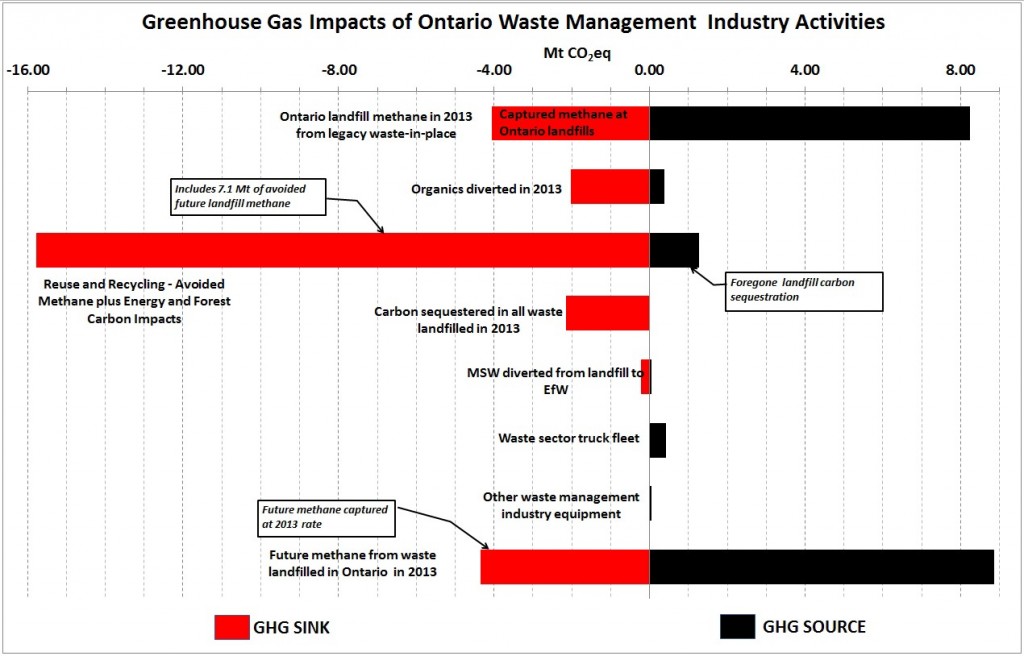Greenhouse Gas Emissions and Ontario’s Waste Management Industry
GLOBE-Net, December 28, 2015 – There is a strong complementarity between the aspirations of the waste management industry and Ontario’s goals for climate change mitigation, a circular economy and sustainable economic development according to a new report published by the Ontario Waste Management Association.
As the Province of Ontario prepares to implement a “cap-and-trade” policy for greenhouse gas (GHG) emissions, Ontario’s waste management industry stands to influence greenhouse gas emissions in a number of ways, suggests the report, including direct and obvious sources of emissions like landfill gas emissions and the tailpipe emissions from its fleet of heavy trucks, but also through an enormous positive contribution to limiting greenhouse gas emissions.
Every year, according to the report, industry activities reduce current and future greenhouse gas emissions in Ontario by 22 million tonnes CO2eq, 14 Mt CO2eq more than the 8 Mt CO2eq of landfill gas emissions from the legacy waste-in-place in all Ontario landfills.
Even so, landfill gas capture, recycling and organic waste diversion rates are still relatively low and will need to increase dramatically for the province to meet its emission reduction targets and make the transition to a sustainable, low carbon and circular economy.

The waste management industry is well positioned to access the substantial regulatory value that will be created by placing a cap on carbon emissions, notes the report’s authors, Maria Kelleher (Kelleher Environmental), Christina Seidel (sonneverra international corp.), and Ralph Torrie (Torrie Smith Associates). Such can be realized through the creation of offset protocols that facilitate growth in landfill gas capture and organics diversion, through partnerships with capped emitters who will value the carbon-free energy generated at waste management facilities.
Benefits are also available through investment in efficiency and low carbon alternatives in their own operations, and through creative partnerships with government for the direct investment of allowance auction revenue in building the foundation for the circular economy.
The development of a carbon allowance market, including offset protocols for landfill gas capture and organics diversion, will improve the economics of a number of industry options that if implemented would help the province meet its climate change mitigation goals. These include:
- Broader coverage and more efficient technology for landfill gas capture
- Increased rates of organic diversion to composting, digestion and EfW facilities
- Capture and cleaning of gases from landfills, digesters, and EfW facilities for injection in to the natural gas pipeline system
- Increased value for direct use of gases from landfills, digesters and EfW facilities, and
- Increased rates of materials recycling and reuse throughout the economy.
With regard to reuse and recycling, the report suggests the industry should press for the early development of offset protocols and/or other mechanisms for increasing the reuse and recycling rates of emissions-intensive materials such as paper products, plastics, glass, aluminum steel, and other metals.
This is not only the option with perhaps the largest growth potential for emission reductions from the industry, but also a key to realizing the goals the province has set for a “waste free Ontario” states the report;
The industry should now work with the government to analyze the impact of the cap-and-trade program on the economics of these options, under a range of plausible allowance price scenarios, to determine how best to design the related protocols, and to identify where direct investment of regulatory income or other policy options may improve the economics or risk profiles of the emission reduction options the industry has to offer.
The complementary between the aspirations of the waste management industry and Ontario’s climate related goals suggest that a successful collaboration between industry and government should be achievable.
The annual contribution by the waste management industry to reducing greenhouse gas emissions is at least twenty times larger than the emissions from the trucks and other equipment it uses to achieve this result. Government policy, including cap-and trade should be designed to maintain and increase this positive impact, concludes the report.



